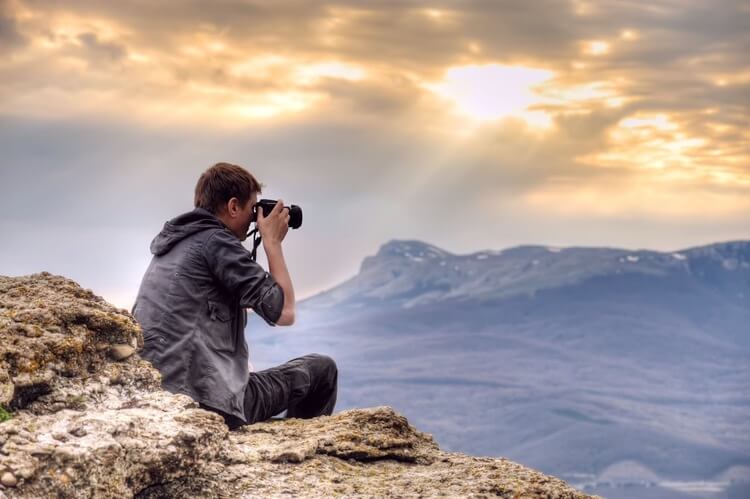Choice of cameras for beginner or professional photographers: rating in 2021-2022 and which one to buy to get high quality pictures
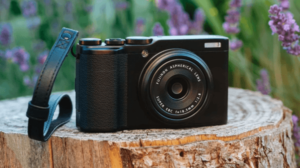 A camera is a special device for capturing objects on film or digital frame.
A camera is a special device for capturing objects on film or digital frame.
Despite the fact that all modern smartphones are equipped with cameras, and quite good ones, they do not always have enough features, memory or simple ergonomics.
A good camera is an extension of the photographer's eyes and hands. How to choose in all the variety on the market today?
Rating TOP 20 best cameras 2021-2022
| Place | Name | Price |
|---|---|---|
| Top 4 best cameras for quality photos | ||
| 1 | Nikon D3500 Kit | Check price |
| 2 | Nikon Z50 Kit | Find out the price |
| 3 | Canon EOS M50 Kit | Find out the price of |
| 4 | Sony Alpha ILCE-6000 Kit | Find out the price |
| Top 4 best DSLRs for beginner photographers | ||
| 1 | Canon EOS 4000D Kit | Expected price |
| 2 | Nikon D5600 Kit | Learn more about the price |
| 3 | Canon EOS 2000D Kit | Find out the price of |
| 4 | Canon EOS 250D Kit | Learn more about the price |
| Top 3 best professional DSLRs | ||
| 1 | Canon EOS 5D Mark IV Body | Learn the price |
| 2 | Nikon D750 Body | Learn the price |
| 3 | Canon EOS 6D Mark II Body | Find out the price |
| Top 3 best mirrorless cameras with interchangeable optics for beginner photographers | ||
| 1 | Panasonic Lumix DMC-G7 Kit | Check price |
| 2 | Olympus Pen E-PL8 Kit | Find out the price |
| 3 | Canon EOS M100 Kit | Find out the price |
| Top 3 best professional mirrorless cameras | ||
| 1 | Sony Alpha ILCE-6400 Kit | Learn the price |
| 2 | Sony Alpha ILCE-7M3 Body | Learn the price |
| 3 | Sony Alpha ILCE-7M3 Kit | Find out the price |
| Top 3 best digital (compact) cameras | ||
| 1 | Sony Cyber-shot DSC-RX100 | Expected price |
| 2 | Canon PowerShot G9 X Mark II | Check price |
| 3 | Fujifilm XF10 | Find out pricing |
Content
- Top 20 Best Cameras of 2021-2022
- How to choose a good camera?
- Camera types
- Which is better - DSLR or mirrorless camera?
- What to choose - DSLR or digital camera?
- What is the difference between cameras for beginners and for professionals?
- What are the best cameras for good images?
- The best DSLRs for beginner photographers
- The best professional DSLRs
- Best Mirrorless Cameras with Interchangeable Optics for Entry-level Photographers
- Best professional mirror less cameras
- The best digital (compact) cameras
- Shopper Reviews
- Useful video
How to choose a good camera?
The camera has many different parameters, for beginner photographers should consider the main indicators:
- Matrix. The size of the image sensor affects sensitivity and dynamic range, which reduce digital noise in the image;
- Resolution. Measured in megapixels and reflected in the final photo. A large value of Mp increases the amount of noise;
- Zoom ratio. Characterizes the camera's ability to shoot distant objects. Define two kinds - digital and optical, the first spoils the quality when zooming in, the second changes the location of the lens and does not degrade the image.
Important characteristics for the operation of the device:
- Screen;
- Shooting modes;
- Battery type;
- Connectors (branded or standard);
- Removable memory storage.
For professional shooting, the following features are considered:
- Optics. Determines the quality of the photo, the main characteristic is the focal length, measured in mm;
- Krop Factor. Affects the angle of view using optics with a smaller frame window;
- RAW format. Provides greater detail and eliminates quality errors;
- Megapixels. The number depends on the size of the sensor, the number of dots shows the size of the image that can be printed without losing quality;
- Light Sensitivity. A high parameter clears up noise and gives a natural image.
Types of cameras
There are three types of digital cameras:
- Compact. Characterized by small size and weight, no viewfinder, a fixed lens. Provides automatic settings, high-quality shooting only in daylight, battery capacity allows up to 200 shots;
- Mirror. The device for professional use, used for shooting both moving and static objects. Features - large size because of the functionality, interchangeable lens, modes, high-resolution sensor, SLR optical viewfinder. The key principle is that the mirror is raised before you start, and the light falls exactly on the sensor. Has a lot of manual settings and has a high price tag;
- Mirrorless. There is no moving mirror and pentaprism, which reduces the size, control is simplified, but has internal advanced functions. Viewfinder electronic, not spoiling quality because of the matrix, the optics are interchangeable. Uses a fast battery consumption due to the constant operation of the sensor and viewfinder.
What's better - a DSLR or mirrorless camera?
DSLRs are much larger, heavier and more demanding to care for..
Mirror-less cameras are smaller, easier to handle and easier to learn. At the same time mirrorless cameras have a big advantage in terms of video recording.
The common features of a DSLR and mirrorless camera that do not affect the quality of shooting are the sensor and interchangeable optics.
The advantages of a mirrorless device - size, electronic viewfinder, choice of manufacturers.
The mirrorless unit has a larger fleet of lenses, long operating time, optical viewfinder, phase autofocus, turn-on time and ergonomics.
What should I choose - a DSLR or a digital camera?
Making a decision in favor of buying a digital or SLR camera depends on factors:
- Quality of the photo;
- The size of the equipment;
- The subject to be photographed;
- Image size;
- Automatic or customizable use.
A DSLR is distinguished by its shooting capabilities and modes, the presence of a viewfinder, high image detail, quality and clarity of photographs, which is characterized by the features of the optics and sensor.
A digital device has compact dimensions, functionality (in more expensive devices), safety features and additional features.
Lately, the SLR cameras are no longer perceived as purely professional and inaccessible to ordinary people and beginners.
And yet, it's worth giving preference to DSLR models for taking professional shots.
What is the difference between cameras for beginners and for professionals?
The main difference is the speed and accuracy of automation, the number of controls and advanced settings, the ability to use the camera in harsh conditions.
For the professional photographer, manual adjustments, which may not be present in amateur cameras, have an impact, so advanced controls differentiate between cameras for beginners and experts in the field.
The best cameras for quality shots
Nikon D3500 Kit
An amateur DSLR that's optimal for beginners and amateurs. 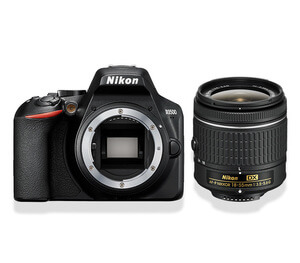
The ergonomics of the model has been thought out in detail: compact size, deep grip, metal mount mount.
The device with a mirror viewfinder covers the field of view by 95% and is equipped with a 3-inch LCD display.
The sensor supports a maximum number of pixels 6000?4000, 100-3200 ISO auto sensitivity with the ability to adjust - ISO6400, 12800, 100, 25600.
Exposure bracketing is present, metering: 3D color, center-weighted, multi-zone, spot.
Exposure time and aperture can be adjusted in manual mode, there is automatic exposure processing.
Focusing has backlighting, electronic rangefinder, face focus and manual adjustment.
SDHC, SD, SDXC memory cards are used. Video recording is designed for 29 minutes (4 GB) in MOV format.
Functions - white balance adjustment automatically, manually, selectively by list. The flash is built in with red-eye reduction.
It is worth noting that this is one of the best models 2021-2022.
Technical features:
- Type - SLR;
- Sensor: view/size/crop/MP - CMOS/ 23.2 x 15.4 mm/1.5/ 24.78;
- Timer/timer shooting - 2,5,10,20s/5fps;
- Shutter opening (X-Sync) - 30-1/4000s (1/200c);
- Autofocus/number of points - phase/11;
- Frame parameter - JPEG (2 levels of compression), RAW;
- Battery is own, for 1550 photos;
- Video resolution, frequency - 50-60 fps at 1280?720; 50-60 fps at 1920?1080;
- Dimensions/weight - 124x97x70mm/365g.
Pros of
- Shooting modes;
- Ergonomics;
- The quality of images;
- Weight;
- Focus speed.
Cons
- Lack of USB charging.
Nikon Z50 Kit
A device with an electronic viewfinder and 100% field of view. LCD touch screen 
The sensor has a resolution of 6048?4024, a sensitivity of 50-3200 ISO and advanced modes - ISO51200, 6400, 12800, 50, 102400, 204800, 100, 25600. Exposure bracketing and metering systems are built in.
Exposure correction +/- 5 EV in 1/3-step increments, auto-processing, manual adjustment of freeze time and aperture are possible.
Autofocus with illumination and by face, can be corrected manually.
Supports XQD drive, USB port with charging, microphone input and headphone output.
Video is recorded in MOV and MP4 format with a duration of 29 minutes. Functions - matrix cleaning; manual, auto and by list white balance correction; optical image stabilization with matrix shift.
i-TTL flash with red-eye reduction. Possibility of computer control or remotely, works in Time-lapse mode, the size of a frame at photographing 3:2, 1:1, 16:9. Interchangeable optics mount Nikon Z.
Technical features:
- Type - mirror-less;
- Sensor: view/size/crop/MP - CMOS/ 35.9?23.9 mm/1/25.28;
- Timer/timer shooting - 2,5,10,20s/12fps;
- Shutter opening (X-Sync) - 30-1/8000s (1/200c);
- Autofocus/number of points - Hybrid/273;
- Frame parameter - JPEG (2 levels of compression), RAW, TIFF;
- Battery- own, for 310 photos;
- Video resolution, frequency -120 fps at 1920?1080;25-30 fps at 3840?2160;
- Dimensions/weight 134x101x68mm/585g.
Pros of
- Ergonomics;
- Autonomous operation;
- Lens;
- Shooting quality;
- High working ISO.
Minuses
- One XQD memory card.
Canon EOS M50 Kit
The camera works with an electronic viewfinder, the LCD is a 3 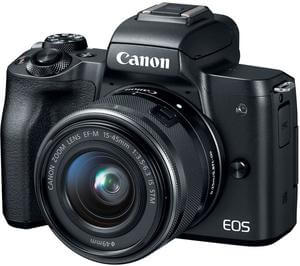
Time-lapse shooting, bursts of up to 33 for JPEG and up to 10 for RAW, picture formats 4:3, 3:2, 1:1, 16:9.
Sensor with a number of pixels 6000? 4000, autosensitivity - 100-3200 ISO with customizable modes ISO6400, 12800, 100, 25600.
Exposure bracketing and autoprocessing, center-weighted, general, spot metering, exposure correction +/- 3 EV in 1/3 step, manual adjustment of aperture and exposure time.
Focus by face, manual selection, backlit autofocus.
Supports SDHC, SD, SDXC memory cards, video is recorded in MP4 format for up to 29 minutes.
Adjustable white balance, E-TTL II flash built-in, works up to 5 m, suppresses red-eye effect.
Orientation sensor built in, computer or remote control possible, sensor cleaning function and HDR shooting, interchangeable lens.
Technical features:
- Mirror-less type;
- Sensor: view/size/crop/MP - CMOS/22.3 x 14.9 mm/1.6/ 25.8;
- Timer/shot rate - 2.10s/10fps;
- Shutter opening - 30 - 1/4000s;
- Autofocus/number of points - Contrast/143 (99 cross);
- Frame parameter - JPEG (2 levels of compression), RAW;
- Battery pack - own, for 235 photos;
- Video resolution, frequency - 120 fps at 1280?720; 50-60 fps at 1920?1080; 25-30 fps at 3840?2160;
- Dimensions/weight -116x88x59 mm/387 g.
Pros
- Sensor;
- Autofocus;
- Functionality;
- Picture quality;
- Settings.
Cons
- Lack of accurate display of remaining battery;
- No on-screen information about free memory card space.
Sony Alpha ILCE-6000 Kit
The camera is equipped with an electronic viewfinder, swiveling 3 "LCD screen. Sensor with 
Exposure bracketing, metering: multi-zone, center-weighted, spot. Exposure compensation, autoprocessing, and manual adjustment of lock time and aperture are available.
Autofocus with illumination, manual adjustment and face focus. Supports Memory Stick/Duo/PRO-HG Duo/Pro Duo, SDHC, SDXC, SD.
AVCHD and MP4 video recording, HDR shooting, 3:2, 16:9 frame size.
Performs sensor cleaning, 3D shooting, flash up to 6m, white balance adjustment, 4x digital zoom, remote or computer control
Technical features:
- Type: mirror-less;
- Sensor: view/size/crop/MP - CMOS/23.5 x 15.6 mm/1.5/24.7;
- Timer/timer shooting - 2.10s/11fps;
- X-Sync shutter opening - 1/100c;
- Autofocus is hybrid;
- Frame parameter - JPEG (2 levels of compression), RAW;
- Battery - own, 360 photo, 1080 mAh;
- Video resolution, frame rate - 50-60 fps at 1920?1080;
- Dimensions/weight - 120x67x45 mm/285 g.
Pros of
- The clarity of the images;
- Control;
- High ISO;
- Manual adjustments;
- Lens.
Cons
- Number of optics available;
- Frequent cleaning of the sensor.
The best DSLRs for beginner photographers
Canon EOS 4000D Kit
DSLR device with a 2.7" LCD viewfinder. A series of shots of up to 6 frames in 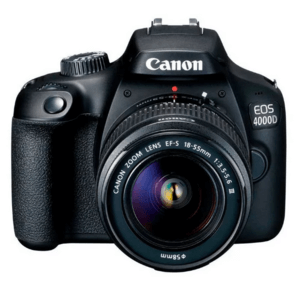
The maximum number of pixels in the matrix is 5184? 3456, auto sensitivity in the range of 100-3200 ISO with a choice of ISO6400, 12800, 100.
There is a manual adjustment of exposure time and aperture, auto exposure processing.
Exposure compensation, metering - evaluation, center-weighted, total, spot; bracketing.
Focus by face, backlight and possible manual correction. SDHC, SD, SDXC memory cards, RAW+JPEG recording simultaneously.
Up to 29 minutes of MOV video (4GB).
Can be computer control or remote, white balance adjustment, E-TTL II flash up to 9.2 meters range with red-eye reduction.
Technical features:
- Type - reflex;
- Sensor type/size/crop/MP - CMOS/22.3 x 14.9 mm/1.6/ 18.7;
- Timer/timer mode - 2-10s/3fps;
- Shutter opening (X-Sync) - 30-1/4000s (1/200c);
- Autofocus is phase;
- Frame parameter - JPEG (2 levels of compression), RAW;
- Battery- own, for 500 photos;
- Video resolution, frequency - 50-60 fps at 1280?720; 25-30 fps at 1920?1080;
- Dimensions/weight - 129x102x77 mm/436 g.
Pros of
- Interface;
- Autonomous operation;
- Functionality;
- The quality of images.
Cons
- Lack of stabilization;
- Hard fixation of the display.
Nikon D5600 Kit
The device is equipped with a reflective viewfinder with a field of view of 95%, equipped with an LCD
Compatible with Time-lapse mode and 3:2 frame. Auto sensor sensitivity is 100-3200 ISO with advanced settings of ISO6400, 12800, 100, 25600, resolution 6000?4000.
Exposure bracketing, auto-processing and metering system functions.
Exposure compensation ± 5 EV in 1/3-step increments, manual adjustment of aperture and fixing time.
Autofocus with single-shot, AI focus, tracking, face, manual focus modes.
Supports removable SDHC, SD, SDXC, Wi-Fi, USB, Bluetooth, HDMI, NFC and microphone input.
MOV video recording, HDR shooting. There are remote control or from a computer, sensor cleaning, orientation sensor.
Technical features:
- Type: SLR;
- Sensor: View/Size/Crop Factor/Mp - CMOS/23.5 x 15.6 mm/1.5/24.78;
- Timer/timer shooting - 2,5,10,20s/5frame/sec;
- X-Sync shutter opening - 1/100c;
- Autofocus/number of points - phase/39;
- Frame parameter - JPEG (3 levels of compression), RAW;
- Battery is own, for 820 photos;
- Video resolution, frequency - 60 fps at 1280?720; 60 fps at 1920?1080;
- Dimensions/weight - 124x97x70 mm/420 g.
Pluses
- Wireless technology;
- Sharpness and clarity of the image;
- Controls;
- Manual settings.
Cons
- Quality in low light.
Canon EOS 2000D Kit
The camera with an optical viewfinder and visibility coverage of 95% is equipped with an LCD display. 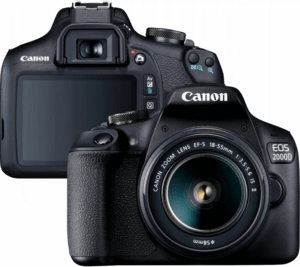
Exposure metering systems are center-weighted, general, spot, bracketing and exposure correction.
Aperture or shutter priority auto-processing, manual changes.
Focus with backlight, manual mode and face.
Supports SDHC, SD, SDXC memory cards, dual RAW+JPEG recording mode, 29-minute MOV video.
E-TTL II flash built-in, external flash can be connected, range up to 9 m.
White balance can be adjusted manually, automatically or by list. Interchangeable optics with Canon EF/EF-S mount.
Technical features:
- Type: SLR;
- Sensor: View/size/crop/MP - CMOS/22.3 x 14.9 mm/1.6/24.7;
- Timer/timer shooting - 2-10s/3fps;
- Shutter opening - 30-1/4000s;
- Autofocus - phase;
- Frame parameter - JPEG (2 levels of compression), RAW;
- Battery- own, for 500 photos;
- Video resolution, frequency - 50-60 fps at 1280?720; 50-60 fps at 1920?1080;
- Dimensions/weight - 129x101x78 mm/475 g.
Pros of
- Built-in settings;
- Wide optical spectrum;
- Ergonomics;
- Matrix.
Cons
- Weak processor;
- Lack of a center contact on the shoe.
Canon EOS 250D Kit
The camera has a mirror-like viewfinder and a touch-sensitive, swiveling LCD screen with a 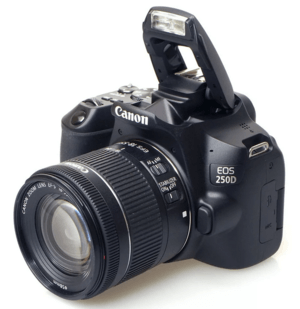
The sensor has a sensitivity of 100-25600 ISO and extended ISO6400, 12800, there is automatic cleaning.
Exposure bracketing and exposure correction are used. Metering: Center-weighted, general, spot; automatic processing and manual adjustment of exposure time and aperture.
SDHC, SDXC, SD memory cards; has microphone input and remote control jack. Record video in MOV, MP4 up to 30 minutes, 4:3, 3:2, 1:1, 16:9 photo format.
Supports remote control, orientation sensor, white balance correction, and optical image stabilization.
Built-in flash with a working radius of up to 10 meters Interchangeable lens mount Canon EF.
Technical features:
- Type - SLR;
- Sensor: View/size/crop/MP - CMOS/22.3 x 14.9 mm/1.6/25.8;
- Timer/timer shooting - 2.10s/5fps;
- Shutter opening (X-Sync) - 30-1/4000s (1/200c);
- Autofocus/number of points - phase/9;
- Frame parameter - JPEG, RAW;
- Battery - own, for 1070 photos;
- Video resolution, frequency - 50-60 fps at 1280?720; 50-60 fps at 1920?1080; 24 fps at 3840?2160;
- Dimensions/weight 122x93x70 mm/451 g.
Pros of
- Picture quality;
- Video mode;
- Autonomous operation;
- Rotating screen.
Cons
- Autofocus;
- Factory settings.
Best professional DSLRs
Canon EOS 5D Mark IV Body
DSLR camera with a viewfinder, equipped with an LCD display and a second screen. At 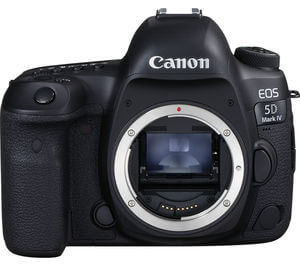
The sensor works with auto sensitivity in the range of 100-3200 ISO with additional parameters ISO51200, 6400, 12800, 102400, 100, 25600.
Auto exposure processing with shutter or aperture priority, manual adjustment of exposure time is possible.
The metering system is divided into Center-weighted, Evaluative, Spot, Bracketing and Exposure Correction.
Autofocus is manually corrected, with backlighting and face focus. Supports removable SDHC, SD, SDXC, Compact Flash/type II, dual RAW+JPEG mode. Video recording lasts 29 minutes in two formats: MOV and MP4.
There is protection against dust and moisture, matrix cleaning, Live View mode. Supports interchangeable lens mount Canon EF.
Features remote or computer control, orientation sensor, GPS, white balance adjustment (auto and manual).
E-TTL II flash with red-eye reduction and sync terminal. The kit lens is not available.
Technical features:
- Type - SLR;
- Sensor: Type/Size/Crop Factor/Mp - CMOS/36?24 mm/1/31.7;
- Timer/timer shooting - 2.10s/7fps;
- X-Sync shutter opening - 1/100c;
- Autofocus/number of points - phase/61 (41 cross);
- Frame parameter - JPEG (3 levels of compression), RAW;
- Battery is own, for 900 photos;
- Video resolution, frequency - 120 fps at 1280?720; 50-60 fps at 1920?1080; 25-30 fps at 4096?2160;
- Dimensions/weight 151x116x76 mm/800 g.
Pros of
- ISO range;
- Touch screen;
- Remote control;
- File transfer to another device;
- Autofocus.
Cons
- Battery life.
Nikon D750 Body.
SLR viewfinder device, 3.2? LCD swivel display with optional 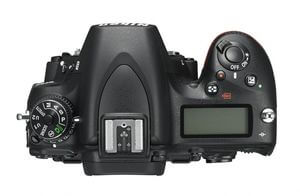
The maximum number of sensor pixels is 6016?4016, sensitivity 50-3200 ISO with a choice of ISO51200, 6400, 12800, 100, 25600.
Exposure has matrix, center-weighted and spot metering, automatic processing with shutter or aperture priority.
Manual lock time or aperture, bracketing, and exposure compensation are possible.
Electronic rangefinder, backlight, manual and face correction can be used when focusing.
Compatible memory cards: SDHC, SD, SDXC; video recording in MOV format up to 30 minutes.
Adjustable white balance, orientation sensor, the possibility of computer control or remotely.
The flash is built in with a range of up to 12 meters, suppresses red-eye effect. Additionally there is a HDMI Type C connector and active D-Lighting bracketing.
This model is highly reliable for 2021-2022.
Technical features:
- Type - SLR;
- Sensor: View/size/crop/MP - CMOS/35.9 x 24 mm/1/24.93;
- Timer/timer shooting - 2,5,10,20s/6,5fps;
- Shutter opening (X-Sync) - 30-1/4000s (1/250c);
- Autofocus/number of points - phase/51 (15 cross);
- Frame parameter - JPEG (3 levels of compression), RAW;
- Battery pack - own, for 1230 photos;
- Video resolution, frequency - 50-60 fps at 1280?720; 50-60 fps at 1920?1080;
- Dimensions/weight 141x113x78 mm/750 g.
Pros of
- Speed and accuracy of autofocus;
- ISO performance;
- Battery life;
- Compactness and ergonomics.
Cons
- Weak contrast autofocus;
- Buffer size.
Canon EOS 6D Mark II Body
The device is equipped with a mirror viewfinder with a field of view of 98%, the LCD screen 3? 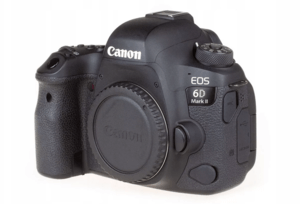
Frame sizes - 4:3, 3:2, 1:1, 16:9, continuous shooting with 150 shots for JPEG and 21 for RAW.
Sensitivity of the sensor 100 - 3200 ISO, extended ISO51200, 6400, 12800, 50, 102400, 100, 25600, resolution 6240?4160.
Exposure metering system is divided into spot, estimated and center-weighted, exposure compensation +/- 5 EV in 1/3-step increments.
Manual adjustment of aperture and exposure time, bracketing ato-processing is possible.
Focus is by face, manually, and autofocus can be adjusted.
Supports SDHC, SD, SDXC. Video is recorded in two formats - MOV, MP4, lasting up to 29 minutes. Functions - white balance adjustment, flash, HDR shooting, GPS, orientation sensor, dust protection. Interchangeable lens mount Canon EF.
The model does not lose its relevance and in 2021-2022.
Technical features:
- Type - SLR;
- Sensor: view/size/crop/MP - CMOS/35.9 x 24 mm/1/27.1;
- Timer/timer shooting - 2.10s/6.5fps;
- Shutter opening (X-Sync) - 30-1/4000s (1/180c);
- Autofocus/number of points - phase/63 (45 cross);
- Frame parameter - JPEG (2 levels of compression), RAW;
- Battery - own, for 1200 photos;
- Video resolution, frequency - 50-60 fps at 1280?720; 50-60 fps at 1920?1080;
- Dimensions/weight 144x111x75 mm/765 g.
Pros
- Focusing;
- Timelapse;
- Electronic video stabilization;
- Ergonomics;
- Standalone operation;
- Protective features.
Cons
- One memory card slot;
- Autofocus points close to the center.
The best mirrorless cameras with interchangeable optics for beginner photographers
Panasonic Lumix DMC-G7 Kit
The camera with an electronic viewfinder features a swiveling LCD display. Shooting 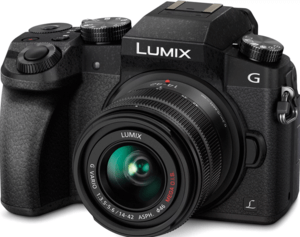
Number of sensor pixels 4592 x 3448, light sensitivity in the range of 100-3200 ISO with in-depth parameters ISO6400, 12800, 100, 25600.
Exposure in autoprocessing is possible with aperture or shutter priority, exposure correction +/- 5 EV in 1/3 step.
Three types of metering: multi-zone, center-weighted and spot metering, manual adjustment of shutter speed and aperture, bracketing.
Focus is determined by face or manual adjustment. Supported memory card types are SDHC, SD, SDXC. Video recording in MP4 and AVCHD formats up to 29 minutes.
Uses interchangeable optics with Micro 4/3 mount, 3D and HDR shooting, 4x digital zoom, white balance adjustment, built-in flash, remote control.
Technical features:
- Type - mirror-less;
- Sensor: View/size/crop/MP - Live MOS/17.3 x 13.0 mm/2/ 16.84;
- Timer/tempo shooting - 2.10s/8frame/sec;
- Shutter opening (X-Sync) - 120-1/16000s (1/160c);
- Autofocus - contrast;
- Frame parameter - JPEG (2 levels of compression), RAW, TIFF;
- Battery - own, 360 photo, 1200 mAh;
- Video resolution, frequency - 25-30 fps at 1280?720; 50-60 fps at 1920?1080;
- Dimensions/weight - 125x86x77 mm/360 g.
Pros of
- Functionality;
- Manual settings;
- Ergonomics;
- Quality.
Cons
- Inaccurate charge indicator;
- Sound on video.
Olympus Pen E-PL8 Kit
The device is equipped with a swiveling LCD touch screen used as a 
Burst shooting allows 20 frames for RAW in 4:3 format.
Sensitivity of the sensor is 200-3200 ISO with adjustable ISO6400, 12800, 25600 and 4608 x 3456 resolution.
Exposure metering systems are multi-zone, center-weighted and spot, with bracketing, autoprocessing, exposure correction, and manual exposure time and aperture settings. Focus by face and manually adjusted with backlight.
Support SDHC, SD, SDXC memory cards, record in two AVI and MOV video formats.
3D and HDR shooting, optical image stabilization with matrix shift, white balance adjustment, and built-in flash are possible. Interchangeable lens - Mount Micro 4/3.
Technical features:
- Type - mirror-less;
- Sensor type/size/crop/MP - LiveMOS/17.3?13mm/2/ 17.2;
- Timer/timer shooting - 2,12,1-30s/8frame/sec;
- Shutter opening (X-Sync) - 60-1/4000s (1/250c);
- Autofocus/number of points - Hybrid/81 (9 cross);
- Frame parameter - JPEG, RAW;
- Battery - own, for 350 photos, 1210 mAh;
- Video resolution, frequency - 25-30 fps at 1280?720; 25-30 fps at 1920?1080;
- Dimensions/weight - 115x67x38 mm/357 g.
Pros of
- JPG quality;
- Stabilizer;
- The number of functions and settings;
- Battery performance.
Cons
- Default menu;
- Heavy weight and uncomfortable ergonomics.
Canon EOS M100 Kit
A device with a swiveling LCD touchscreen that serves as a viewfinder. 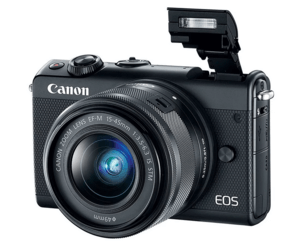
The number of pixels in the matrix 6000?4000, sensitivity 100-3200 ISO, extended options ISO6400, 12800, 100, 25600.
Exposure metering - Center-weighted, Evaluative and Spot metering, EV compensation +/- 3 EV in 1/3-step increments.
Manual adjustment of aperture and exposure time, automatic exposure processing.
Focusing manually or by face with illumination. SDHC, SD, SDXC storage types, interfaces Wi-Fi, USB, Bluetooth, NFC.
Recording 29 minutes of video in MP4 format.
HDR shooting, white balance adjustment, remote control, optics switching. E-TTL II flash with a radius of up to 5 meters with red-eye suppression.
Technical features:
- Type - mirror-less;
- Sensor type/size/crop/MP - CMOS/22.3?14.9 mm/1.5/ 25.8;
- Timer/timer shooting - 2.10s/6.1fps;
- Shutter opening (X-Sync) - 30-1/4000s (1/200c);
- Autofocus/number of points - phase/49;
- Frame parameter - JPEG (2 levels of compression), RAW;
- Battery pack - own, for 295 photos;
- Video resolution, frequency - 50-60 fps at 1280?720; 50-60 fps at 1920?1080;
- Dimensions/weight - 108x67x35 mm/302 g.
Pros of
- Compactness;
- The quality of images at night;
- Wireless technology.
Cons
- Limited functionality;
- Number and price of lenses.
The best mirrorless professional cameras
Sony Alpha ILCE-6400 Kit
The camera is equipped with electronic viewfinder with 100% field of view, touch screen LCD 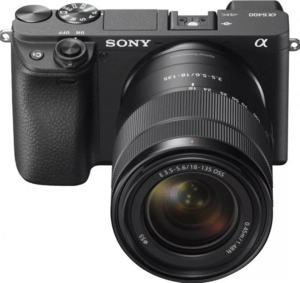
Maximum number of burst shots for JPEG - 116, for RAW - 46, frame sizes 3:2, 1:1, 16:9.
Matrix sensitivity 100-32000 ISO, extended ISO51200, 6400, 12800, 102400, 100, 25600, resolution 6000?4000. Auto exposure processing with aperture or shutter priority, manual shutter speed adjustment, exposure compensation, bracketing.
Autofocus is adjustable, manual adjustment is also possible by face.
Supports memory cards - SDHC, microSDXC, SD, Memory Stick/Duo/PRO-HG Duo/Pro Duo, microSD, SDXC, microSDHC.
Records video with sound but no commentary in AVCHD format. Includes moisture and dust protection, HDR shooting, computer or remote control, 8x digital zoom, USB connector allows you to charge the battery.
White balance is set automatically, manually or by list, built-in flash, it is possible to change the optics mount Sony E.
This model has proven to be excellent in 2021-2022.
Technical features:
- Type - mirror-less;
- Sensor: view/size/crop/MP - CMOS/23.5 x 15.6 mm/1.5/25;
- Timer/timer shooting - 2,3,5,10s/11fps;
- Shutter opening - 30-1/4000s;
- Autofocus/number of points - Hybrid/425;
- Frame parameter - JPEG, RAW;
- Battery - own, for 410 photos;
- Video resolution, frequency - 120 fps at 1920?1080; 25/30 fps at 3840?2160;
- Dimensions/weight - 120x67x50 mm/403 g.
Pros of
- No overheating;
- Processor;
- Quality;
- Ergonomics;
- Silent mode.
Cons
- Battery life;
- Lack of stabilizer.
Sony Alpha ILCE-7M3 Body
The device has an electronic viewfinder with a 100% field of view, a 3? 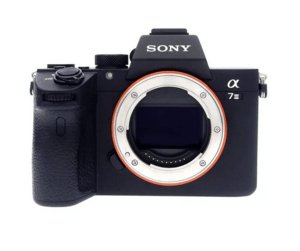
The continuous shooting is designed for 163 frames for JPEG and 89 for RAW, the picture format is 3:2, 16:9.
Matrix resolution 6000?4000, sensitivity 100-3200 ISO, advanced ISO51200, 6400, 12800, 50, 102400, 204800, 100, 25600.
Multi-zone, Center-Weighted and Spot metering, bracketing and Auto Processing are all available.
Exposure compensation +/- 5 EV in 1/3-step increments, manual calibration of exposure time and aperture.
Supports SDXC, SDHC, SD, Memory Stick/Duo/PRO-HG Duo/Pro Duo, AVCHD and MP4 video recording.
Optical image stabilization with matrix shift, built-in flash, white balance adjustment, HDR shooting, interchangeable optics.
Technical features:
- Type - mirrorless;
- Sensor: view/size/crop/MP - EXR CMOS/35.6 x 23.8 mm/1/25.3;
- Timer/timer shooting - 2,5,10s/10fps;
- Shutter opening (X-Sync) - 30-1/8000s (1/250c);
- Autofocus - Hybrid;
- Frame parameter - JPEG (3 levels of compression), RAW;
- Battery is own, for 710 photos;
- Video resolution, frequency -120 fps at 1920?1080; 25-30 fps at 3840?2160;
- Dimensions/weight - 127x96x74 mm/650 g.
Pros
- Focus;
- Viewfinder;
- Shooting speed;
- Functionality;
- Ergonomics.
Cons
- Screen;
- Menu;
- Body quality.
Sony Alpha ILCE-7M3 Kit
The camera is equipped with an electronic viewfinder, a touch-sensitive rotary LCD screen with 
FPS for JPEG 163 and 89 for RAW, 3:2 image size, 16:9 image size.
Sensitivity of the sensor 100-3200 ISO with a choice of ISO51200, 6400, 12800, 50, 102400, 204800, 100, 25600, maximum pixel count 6000?4000.
Exposure is adjusted through bracketing, metering systems, exposure correction, autoprocessing, aperture setting and fixing time.
Focusing is by face or in manual mode with backlighting.
Supports Memory Stick/Duo/PRO-HG Duo/Pro Duo, SDHC, SD, SDXC, AVCHD and MP4 video recording formats.
Image stabilization is optical method with matrix shift, built-in flash suppresses red-eye effect. White balance adjustment (auto and manual), HDR shooting, remote control, interchangeable optics.
Technical features:
- Type - mirrorless;
- Sensor: view/size/crop/MP - EXR CMOS/35.6 x 23.8 mm/1/25.3;
- Timer/timer shooting - 2,5,10s/10fps;
- Shutter opening (X-Sync) - 30-1/8000s (1/250c);
- Autofocus is hybrid;
- Frame parameter - JPEG (3 levels of compression), RAW;
- Battery - own, for 710 photos;
- Video resolution, frequency - 120 fps at 1920?1080; 25-30 fps at 3840?2160;
- Dimensions/weight - 127x96x74 mm/650 g.
Pros of
- Autofocus;
- Autonomous operation;
- The quality of images;
- Video recording.
Cons
- Speed of operation;
- Faded screen.
The best digital (compact) cameras
Sony Cyber-shot DSC-RX100
3? LCD screen is used instead of the viewfinder. The focus distance from the 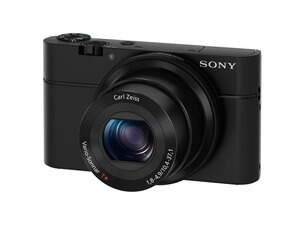
Macro shooting capability, 4:3, 3:2, 1:1, 16:9 frame sizes. Matrix resolution 5472?3648, ISO 80-3200 with ISO6400, 12800, 25600 capabilities.
Exposure with multi-zone, center-weighted and spot metering, possible exposure correction, auto-processing and manual adjustment of aperture and exposure time.
Includes face focus, manual correction, minimum distance of 0.05m.
SDHC, SD, SDXC, Memory Stick/Duo/PRO-HG Duo/Pro Duo slot available.
Dual AVCHD and MP4 video recording with sound. White balance adjustment function, optical image stabilization with movable element in lens. Built-in flash with a range of up to 6.3 m. Additionally, a stereo microphone is available.
Technical features:
- Type - compact;
- Sensor: View/size/crop/MP - CMOS/13.2 x 8.8 mm/2.7/20.9;
- Timer/timer mode: 2.10s/10fps;
- Optical zoom/digital - 3.60x/2x;
- Aperture F1.8-F4.9;
- Autofocus is contrast;
- Frame parameter - JPEG, RAW;
- Battery - own, for 330 photos;
- Video resolution, frame rate - 50-60 fps at 1920?1080;
- Dimensions/weight - 102x58x36 mm/213 g.
Pros
- Sensor;
- Low noise;
- Compactness;
- Capture modes.
Cons
- Ergonomics;
- Expensive accessories.
Canon PowerShot G9 X Mark II
Camera without a viewfinder, the function of which is performed by the LCD touch screen. Focal length 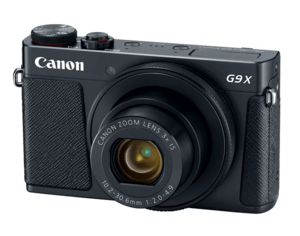
Number of burst shots 38 for JPEG, 21 for RAW, image formats 4:3, 3:2, 1:1, 16:9, work in Time-lapse and macro. Number of sensor pixels 5472 x 3648, sensitivity 125-3200 ISO with extended parameters ISO6400, 12800.
Exposure with manual adjustment of aperture and shutter speed, automatic processing, bracketing, exposure correction and metering systems.
For focusing, the minimum distance is 0.05m, and it is possible to focus manually or by face.
SDHC, SD, SDXC memory cards are used, USB slot with charging support. Video is recorded in MP4 format with a duration of 29 minutes.
The moving part in the lens stabilizes the image, the flash is built in, white balance is set automatically, manually or from a list.
Technical features:
- Type - compact;
- Sensor: view/size/crop/MP - BSI CMOS/13.2?8.8 mm/2.7/20.9;
- Timer/timer shooting - 2.10s/8.2fps;
- Shutter opening (X-Sync) - 30-1/2000s (1/2000c);
- Optical zoom/digital - 3x/4x;
- Aperture F2-F4.9;
- Autofocus - contrast;
- Frame parameter - JPEG (2p. compressed), RAW;
- Battery is own, for 235 photos;
- Video resolution, frequency - 25-30 fps at 1280?720; 50-60 fps at 1920?1080;
- Dimensions/weight - 98x58x31 mm/206 g.
Pros
- Sensor;
- Optical image stabilizer;
- Compactness;
- The number of settings.
Cons
- Battery capacity;
- Inability to take pictures while charging.
Fujifilm XF10
The device uses an LCD touchscreen instead of a viewfinder. Focal length 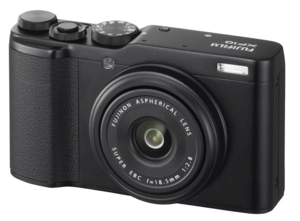
The sensor with a resolution of 6000?4000, sensitivity 200-3200 ISO, in-depth - ISO51200, 6400, 12800, 100, 25600.
Shooting is possible in Time-lapse mode, for JPEG format the maximum number of frames in a series of photos 13 pcs.
Exposure metering: multi-zone, center-weighted, and spot metering; bracketing, exposure correction, auto-processing, and manual adjustment of exposure time and aperture are used.
Minimum focus distance 0.1 m, focus by face or manually.
SDHC, SD, SDXC cards up to 256GB are supported, dual RAW+JPEG recording is possible, USB slot supports charging. Video recording is in MP4 format for 29 minutes.
Built-in flash with a range up to 5.3 m, white balance adjustment.
Technical features:
- Type - compact;
- Sensor: View/size/crop/MP - CMOS/23.5 x 15.7 mm/1.5/24.2;
- Shooting rate - 6 fps;
- Shutter opening - 30-1/16000s;
- Aperture F2.8;
- Autofocus/number of points - Hybrid/91;
- Frame parameter - JPEG (2 levels of compression), RAW;
- Battery is own, for 330 photos;
- Video resolution, frequency - 25-30 fps at 1280?720; 50-60 fps at 1920?1080; 4K 3840?2160 - 15 fps;
- Dimensions/weight - 113x64x41 mm/279 g.
Pros of
- Ergonomics;
- Size;
- Picture quality;
- Controls.
Cons
- Autofocus;
- Battery life.
Customer Reviews
Helpful video
In this video you will learn how to choose your camera:



